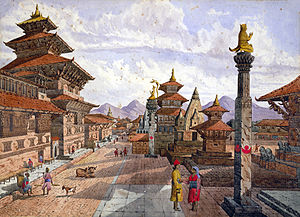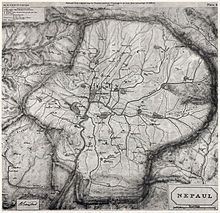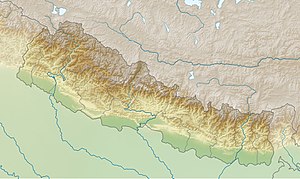
The Kingdom of Nepal was a Hindu kingdom in South Asia, formed in 1768 by the expansion of the Gorkha Kingdom, which lasted until 2008 when the kingdom became the Federal Democratic Republic of Nepal. It was also known as the Gorkha Empire, or sometimes Asal Hindustan. Founded by King Prithvi Narayan Shah, a Gorkha monarch who claimed to be of Thakuri origin from chaubisi, it existed for 240 years until the abolition of the Nepalese monarchy in 2008. During this period, Nepal was formally under the rule of the Shah dynasty, which exercised varying degrees of power during the kingdom's existence.

Prithvi Narayan Shah, was the last king of the Gorkha Kingdom and first king of the Kingdom of Nepal. Prithvi Narayan Shah started the unification of Nepal.

The unification of Nepal was the process of building the modern Nepalese state, from fractured petty kingdoms including the Baise Rajya and the Chaubisi Rajya, which began in 1743 AD. The prominent figure in the unification campaign was Prithvi Narayan Shah, King of Gorkha. On 25 September 1768, he officially announced the creation of the Kingdom of Nepal and moved his capital from Gorkha to the city of Kathmandu.
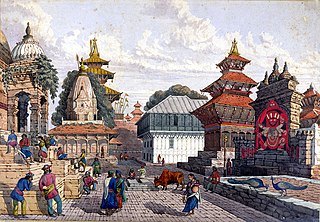
The Malla dynasty also known as the Malla confederacy, was the ruling dynasty of the Kathmandu Valley in Nepal from 1201 to 1779. This dynasty was founded by Arideva Malla. Though the latter Mallas were regarded as belonging to the Raghuvamsha dynasty, they were also seen as continuations and descendants of the Licchavi dynasty. Later Malla kings also traced one section of their lineage from Nanyadeva, the founder of the Karnat dynasty of Mithila. The term malla means wrestler in Sanskrit. The first use of the word malla in the Kathmandu Valley began in 1201.

Jaya Prakash Malla was the last king of Kantipur which corresponds to present-day Kathmandu. He ruled from 1736 to 1746 after succeeding his father Jagajjaya Malla, and then from 1750 until his death in 1769.
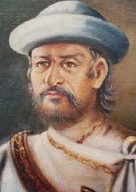
Basnyat/Basnet family or Basnyat/Basnet dynasty was a Khas-Chhetri and a warlord clan family involved in the politics and administration of the Gorkha Kingdom and Kingdom of Nepal. This family got entry into Thar Ghar aristocracy group of Gorkha at the time of King Prithvi Narayan Shah. It was one of the four noble families to be involved in active politics of Nepal together with the Shah dynasty, Pande family and the Thapa dynasty before the rise of the Rana dynasty. This family is descended from Shivaram Singh Basnyat, the commander of Gorkhali forces and a member of Shreepali Basnyat clan of Gorkha. This family was maritally linked to Kala (Black) Pande section of the Pande dynasty through Chitravati Pande who married Kaji Kehar Singh Basnyat. This family was the last Kshatriya (Chhetri) political family to be wiped out from the central power by Jung Bahadur Rana of Kunwar family during the Bhandarkhal Massacre in 1846 for the conspiracy to take the power leading to people suffering from 104 long years of the Rana rule.

Kaji was a title and position used by nobility of Gorkha Kingdom (1559–1768) and Kingdom of Nepal between 1768 and 1846. Many other contemporary kingdoms used the same title for their ministers.
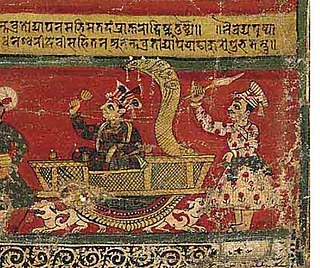
Ranajita Malla was the last king of the Malla dynasty who ruled Bhaktapur from 1722 to 1769. He is widely known for his contribution to Nepal Bhasa literature, in particular his plays are generally praised by modern scholars. He has been generally described as a peace loving, simple and pious monarch who allowed his citizens to advise and criticize him. However, his reign was characterized by constant disputes with Kantipur and Gorkha. He is also known for the crisis of succession during his reign when he favored his concubine's issue over his queen consort's, who was more generally liked, which caused a lot of mutiny in the kingdom especially in cities like Thimi and Banepa.
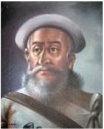
The Shreepali Basnet are a clan of the Chhetris originally from the Saipal, Far West Region who got their prominence in Gorkha district of Nepal. They mainly worship 'Masto' as their 'Kulayan' but saipali from Gorkha has changed their worship to "Sishakoti Mahadev", "Veerabhadra", "Mahakali" as their Kul Deuta and Aradhe Devi "Dakshinkali" as Istha deuta in style of Kunwar Rana. They became very powerful during the unification of Nepal and remained so until the emergence of Jung Bahadur Kunwar or later known as Jang Bahadur Rana.
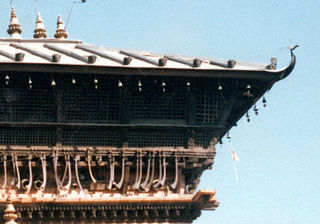
The Battle of Kirtipur occurred in 1767 during the Gorkha conquest of Nepal, and was fought at Kirtipur, one of the principal towns in the Kathmandu Valley. Kirtipur was then a walled town of 800 houses and part of the kingdom of Lalitpur. It is spread along the top of a ridge.

The Battle of Kathmandu or siege of Kathmandu or siege of Kantipur occurred during the Unification of Nepal. It was fought in Kathmandu in 1768, and resulted in the defeat of its king Jaya Prakash Malla by conquerors Prithvi Narayan Shah, king of the adjoining Gorkha Kingdom.

The Battle of Bhaktapur was the final campaign in the Gorkha conquest of Nepal. It took place in Bhaktapur in 1769, and resulted in the victory of the Gorkhali king Prithvi Narayan Shah, giving him control of the entire Kathmandu Valley and adjoining areas.

Vamshidhar Pande known by Alias Kalu Pande was a Nepalese politician and general who was appointed as Kaji of The Gorkha Kingdom. He was born in 1713 A.D. in a Gorkha family. He was the commander of the Gorkhali forces during the Unification Campaign of Nepal who died in the first Battle of Kirtipur in 1757 A.D. Pande's real name was Banshidhar Pande. He was a son of Kaji Bhimraj Pande who was minister during reign of King Prithivipati Shah of Gorkha. He was descendant of Minister of Gorkha and Dravya Shah's accomplice Ganesh Pande. He had three sons: Dewan Kajisaheb Vamsharaj Pande, Sardar Ranasur Pande and Mulkaji Sahib Damodar Pande.

Ram Krishna Kunwar or Ramakrishna Kunwar was a military commander (Sardar) of Gorkha Kingdom during the Unification of Nepal at the reign of King Prithvi Narayan Shah. He was born circa 1728 AD to Ashiram Kunwar in the Kunwar family. His descendants went on to found the Rana dynasty of Nepal. He was a successful general in King Prithvi Narayan Shah's unification campaign of Nepal. He defeated British forces at Hariharpur Gadhi on 25 August 1767. He died in the Mechi Campaign in 1771 A.D.
Tularam Pande was a Nepalese military personnel, diplomat and politician in the Gorkha Kingdom. He was a diplomat who served King Prithvi Narayan Shah of Gorkha. Two of his diplomatic missions were with Dolakha and Kathmandu while the latter remained unsuccessful. He also served as the national military commanders in the forces of Prithvi Narayan Shah. He was the patron of the Gora Pande clan, a minor faction of the Gorkha-based aristocratic Pande family. Some of his patrilineal descendants became influential politicians such as Ranajit Pande and Dalabhanjan Pande in the Nepalese history through their marital ties with the Thapa dynasty. His matrilineal descendants became significantly influential; Queen Tripurasundari of Nepal went on to become Queen Mother of Nepal and Mathawar Singh Thapa – the Prime Minister of Nepal and Jang Bahadur Kunwar Ranaji – the latter period ruler of Kaski and Lamjung and Prime Minister of Nepal.

The Battle of Nuwakot also called Siege of Nuwakot or Invasion of Nuwakot was fought in Nuwakot in 1744. Nuwakot was controlled by the Kingdom of Kantipur and it was an important location as it had a trade route to Tibet. The Gorkha Kingdom previously attacked twice by Nara Bhupal Shah and his son Prithvi Narayan Shah respectively. To prepare for the war Prithvi Narayan Shah visited Varanasi to get war materials, ammunition, acquire weapons, train the soldiers, and Pilgrims. He improved his army personnel and included people from any caste including the blacksmiths, cobblers, sweepers, Damai, and anyone who was bodied and physically fit was able to join the crew.

The Battle of Sindhuli was fought on 6 November 1767 near Sindhuli Gadhi. The battle was part of the unification of Nepal led by Prithvi Narayan Shah, King of Gorkha.
The Kingdom of Lalitpur, also known as Patan, was a kingdom ruled by the Malla dynasty of Nepal. It was established in 1482 after King Yaksha Malla's death. His sons divided the kingdom into four parts: Bhaktapur, Kantipur, Lalitpur, and Banepa.
In the 11th century, a powerful empire of Khas people emerged in western Nepal whose territory at its highest peak included much of western Nepal as well as parts of western Tibet and Uttarakhand of India. By the 14th century, the empire had splintered into loosely associated Baise rajyas, literally 22 states as they were counted. The rich culture and language of the Khas people spread throughout Nepal and as far as Indo-China in the intervening centuries; their language, later renamed the Nepali language, became the lingua franca of Nepal as well as much of North-east India. In south-eastern Nepal, Simraungarh annexed Mithila around 1100 AD, and the unified Tirhut stood as a powerful kingdom for more than 200 years, even ruling over Kathmandu for a time. After another 300 years of Muslim rule, Tirhut came under the control of the Sens of Makawanpur. In the eastern hills, a confederation of Kirat principalities ruled the area between Kathmandu and Bengal.
